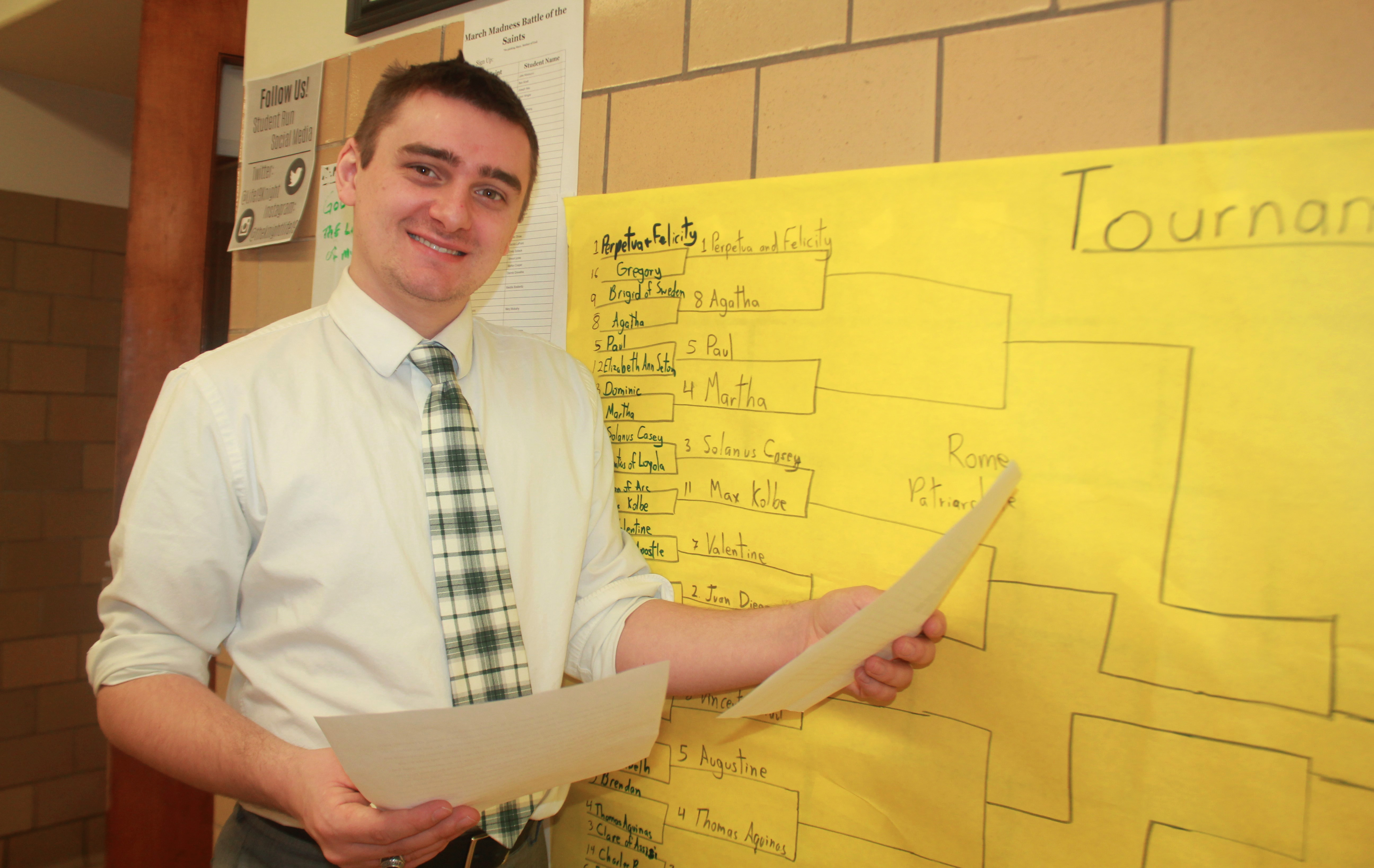Teacher's 'Battle of the Saints' allows students to go head to head with essays of their favorites from Church history
ROYAL OAK — As the final remnants of winter melt away each year, fans of college basketball excitedly fill in their brackets for the NCAA championship tournament.
About the same time each year, students in Brian Folmar’s classes at Shrine Catholic High School get excited about a different type of bracket.
For the fifth year now, Folmar has conducted a 64-participant “Battle of the Saints,” where students taking his Theology of Jesus and Church History courses compete against their peers — essay style — stating why a saint they’ve adopted is head-and-shoulders above the others.
“This is a way for students to release their competitive side a little bit, in a fun way to celebrate sainthood of the Catholic Church,” Folmar said. “Each round they write a half-page to one-page essay explaining why the saint they have chosen to compete with is better than the saint they’re matched up against, and the stronger argument wins and advances to the next round.”
That sounds tricky. Aren’t all saints inherently good?
“This is all premised on a bit of humor — you can’t actually say one saint is better than another,” Folmar explained. “But there is a bit of an offense and a defense. The defense is writing well about your saint, while the offense is, in a way, trying to take the other saint down a notch.”
Students chose their saints online on a first-come, first-serve basis.
“A lot of students think, ‘Oh, I’ll pick St. Francis, St. Dominic — these saints are going to be easy because I know everything about them. But guess what — so does your opponent,” Folmar said. “Some of the strongest arguments are for saints not many people know about.”
Jonah Wisneski, the 2017 Battle of the Saints champion who’s now a senior at Shrine, chose to write about St. Thomas More because that was the parish where he was baptized, and he also chose Thomas as his confirmation name.
“I really kind of empathized and agreed with how he stood up for what he believed in, no matter what, and it ultimately cost him his life — I’ve always respected that,” Wisneski said.
Jess Reaume is the reigning champion, although she isn’t participating this year because she is a junior (Folmar’s classes include freshmen and sophomores). Still, she has fond memories of the annual competition.
“I picked St. Peter because of the miracles that he had done, and so I kind of thought he was just a pretty relatable saint, too; he did all these great things, so you should pick a saint that you can relate to, and the words just kind of start flowing,” she said. “It was really fun to compete against different saints and different people, and it was kind of fun to know that people agreed my saint was the best.”
Names are removed from atop the papers, so the students seldom know whom they’re writing against, as their arguments should be able to stand on their saint’s merit.
“The strongest essays are usually the ones that can somehow tie together two saints’ stories and explain how one was a better example than the other,” Folmar said. “One of the best arguments I ever saw was in a Final Four match-up (a few years ago) between St. Sebastian and Pope John Paul II. What happened was Pope John Paul II, the writer for him, explained that while both saints were almost killed for their faith, the response for St. Sebastian was to ridicule or deride the emperor for his persecution — and St. Sebastian actually got killed, eventually — while Pope John Paul II met with his attacker and actually forgave him and eventually converted him. Which one of those is the more Christ-like action? Both suffered for Jesus, but one really took it the extra mile. That was one of the essays par excellence.”
Folmar reads every essay and decides the outcome, except when the quality of the writing makes it “too close to call” or when he feels he might be biased — then he enlists “other anonymous judges” to help with the decision.
“This year, for example, there was a match-up between St. Joan of Arc — I go to St. Joan of Arc Parish; I love St. Joan of Arc — and Maximilian Kolbe,” Folmar said. “Both saints were comparable, both essays were strong, and quite frankly I wanted to see St. Joan of Arc win, but I took it to a couple of other sources, and they all agreed that (the argument for) Maximilian Kolbe was just a little stronger. I made sure that I didn’t let my bias get in the way.”
What’s the motivation for the participating students? Extra credit in Folmar’s courses, and for the finalists, gift cards to the bookstores of the students’ choice (“because you’ve got to encourage the research and the reading,” he said).
Prior to the saints Wisneski and Reaume chose, the first two tournament winners were St. Rose of Viterbo and St. Anne.
This year’s No. 1 seeds, based on a qualifying-round essay, are St. George, St. John the Baptist, Sts. Perpetua/Felicity and St. Zita. (She’s “the Cinderella story of all of them,” Folmar said).
Who will win? You can follow the tournament’s progress, updated periodically, via Twitter at #BustingHalos2019.
And with all the hours Folmar spends reading essays, does that leave the Michigan State graduate any time to follow the actual NCAA basketball tournament?
“I don’t know too much about college basketball,” he said, “but all I know is ‘Go Green’ … and Jesus loves the Spartans.”
Vote for your favorite saint
In addition to Shrine High School's tournament, the Archdiocese of Detroit is unleashing the Gospel through its own “Saint Madness” tournament on Instagram. Vote for your favorite to win!










